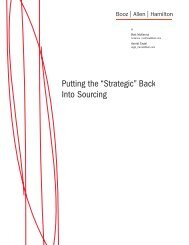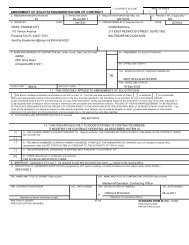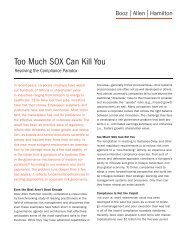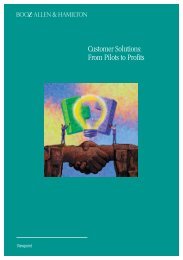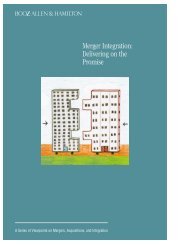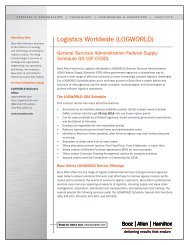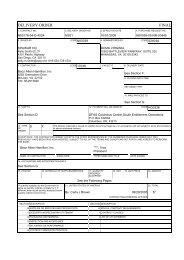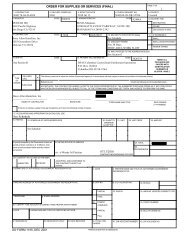Building the Enterprise - Booz Allen Hamilton
Building the Enterprise - Booz Allen Hamilton
Building the Enterprise - Booz Allen Hamilton
- No tags were found...
Create successful ePaper yourself
Turn your PDF publications into a flip-book with our unique Google optimized e-Paper software.
ing principles, we would constructa set of common policies and practicesthat are so fundamental that<strong>the</strong>y, too, should cover every federalagency, regardless of mission or circumstance—forexample, a commonbut modernized job classificationsystem to ensure generally equal payfor equal work across agencies anda common, market-based compensationregime tied to that classificationstructure to ensure parity with<strong>the</strong> U.S. labor market. A commonsenior executive corps—today <strong>the</strong>reas many as seven—would foster interagencymobility and <strong>the</strong> developmentand deployment of <strong>the</strong> cadreof leaders so critical to enterprisegovernment.The enterprise civil service systemwe propose is not rigid. There istoo much variety—in statutory base,size and scope, mission, constituencyand budget—across <strong>the</strong> federalenterprise to force lockstep uniformity.Instead, it would balance commonalityat <strong>the</strong> core with built-inagency flexibility. Thus, agencieswould be given considerable discretion—moreso than today’s rules allow—totailor elements of <strong>the</strong> commonstructure to meet <strong>the</strong>ir ownunique needs so long as <strong>the</strong>y staytrue to <strong>the</strong> system’s foundational elementsand parameters.For example, we would permitagencies to customize salary ratesfor mission-critical occupations,promotion and career patterns, performancemanagement policies anda host of o<strong>the</strong>r workplace practices.Consistent with today’s demonstrationauthority, we would affordagencies <strong>the</strong> authority to customizeeven components that are intendedto be common across <strong>the</strong> enterprise,subject to collective bargainingwhere required. An agency wouldearn approval to operate a customizedsystem by demonstrating highmission performance, includingemployee engagement and high internalintegrity, as well as by showingthat it has <strong>the</strong> human capital andleadership capacity necessary to operateresponsibly outside <strong>the</strong> lines.This autonomy would have to be periodicallyreexamined and renewed.Such a civil service systemwould improve <strong>the</strong> ability of <strong>the</strong>enterprise to recruit and retain ournation’s best and brightest talent.None<strong>the</strong>less, much would dependon <strong>the</strong> substance of <strong>the</strong> human capitalpolicies. And if <strong>the</strong>re is one lessonwe have learned over <strong>the</strong> decades“The civil service today reflects<strong>the</strong> needs and characteristics of<strong>the</strong> last century’s governmentwork and workforce, not thoserequired for today’s complex,interagency challenges.since <strong>the</strong> last time <strong>the</strong> civil servicesystem was modernized, it is <strong>the</strong> importanceof strategic human capitalplanning.Thus, OPM should devise anenterprise strategic human capitalplan with consultation from enterprisegoal leaders and ratified by <strong>the</strong>PMC. The plan would have two primarypurposes. First, it would lookinto <strong>the</strong> near- and medium-term futureto address critical, cross-cuttinghuman capital challenges affectingmost agencies—for example, recruitingand retaining talent in cybersecurityand science, technology, engineeringand math.The second purpose would be tocontinuously assess <strong>the</strong> enterpriseefficacy of human capital policiesand strategies. This rarely is donetoday.OPM evaluates individual departmentsand agencies, mostly froma compliance standpoint. But it hasnot stepped back to evaluate froma whole-of-government perspectiveregarding how well <strong>the</strong> GeneralSchedule classification systemstacks up against state-of-<strong>the</strong>-artprivate-sector practices, <strong>the</strong> effectsof pay freezes on retention or <strong>the</strong>value of tuition loan repayment onrecruiting talent. Such comparisonslargely have been left to <strong>the</strong> GAO or<strong>the</strong> Merit Systems Protection Board.Both do a credible job, but <strong>the</strong>ir studiesrarely translate into action.This would change under anenterprise strategic human capitalplanning process that regularlyconsiders such issues, assesses <strong>the</strong>irimpact on <strong>the</strong> ability of agencies andenterprise goal leaders to recruitand retain talent, and proposes andputs into effect medium- and longtermsteps to address human capitalneeds. •”22 PARTNERSHIP FOR PUBLIC SERVICE | BOOZ ALLEN HAMILTON





